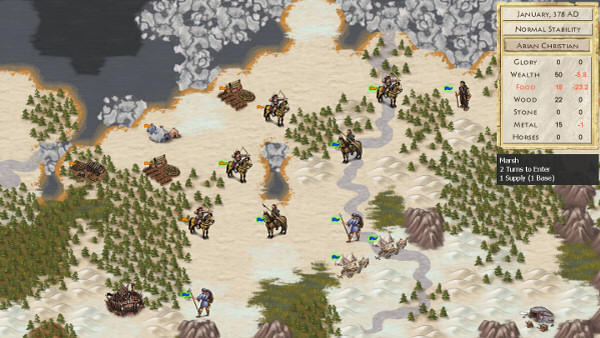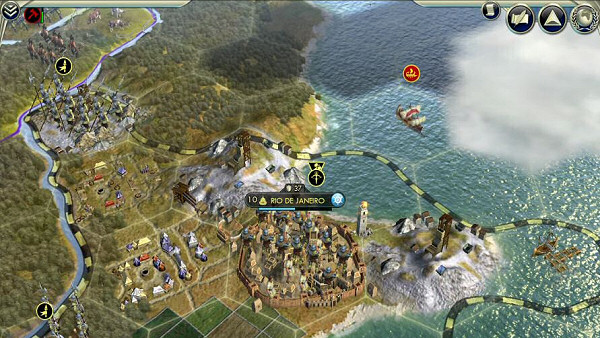
Jon Shafer succeeded on Kickstarter with At the Gates, his new 4X game project set on the Roman declining phase where the Barbarian tribes rampage against the old order of power. But, this isn’t really news, as Jon’s success on Kickstarter was easy to see coming only a couple of days after his announcement. The goal was probably not that high though.
In his recent Kickstarter update, Jon talks about Civilization 5, revisits some of its design aspects and puts everything on the table. What went right, what went not so right, but primarily what went wrong. Why was that, and what has he learned in the process. He then talks about how his past design experience with Civ5 has helped shape his vision for At the Gates.
This is a great article, which I recommend to any Civ fanatic, game designer, 4X gamer or general strategy gaming enthusiast. In it Jon talks about the decisions he made which took the Civilization franchise on a different direction from its predecessors, while at the same time doing his best to answer people who ask: “How does [ATG] compare to Civ5, the last game you designed?“.
As a Civ fanatic, it’s a pleasure, and a privilege, to know what went in a Civ designer’s mind when he decided the major changes for a new installment, or even the smaller twists to the franchise. Jon addresses Civ5 aspects like diplomacy (yes, completely not fun at release), combat system 1UPT and the AI (or lack of thereof), about the health system removal, global happiness and the way resources work. In a very humble tone, Jon explains why he designed Civ5 the way he did, why he thinks some things didn’t turn out that great, and what he has learned in the process while talking about ATG’s own direction.
I think Jon is perhaps too critical of himself in this article, and I think he did much better than one might think after reading it. But, he does touches on the hot subjects only, and that’s why probably I got this feeling. Moreover, Civ5 today is very different from Civ5 at release time. So, I strongly agree with him when he says: “My friends over at Firaxis have done an excellent job improving the gameplay following my departure”. Yes Jon, they did, a remarkable job.
A bit lengthy, but definitely a worthy read.

40 Comments
Related Articles:
- Civ5 Designer Jon Shafer on Kickstarter for 4X At the Gates
- XCOM: Enemy Unknown Video – The Love for X-COM
- Julian Gollop’s X-COM: UFO Defense Postmortem at GDC
- Interview with Conifer Games on At the Gates
- Endless Space – A New 4X Space Game by Amplitude Games








CiV5 seems deep but is shallow, i bought it (+Expansions) without any prejudices on my mind and i dont regret it. but i came back to CiV4 way too soon.
I hope at the gates is not that streamlined.
It can take a while to let go Civ4, especially Civ4:BTS and embrace Civ5. Now, with the Gods&Kings expansion the transition process is much easier and faster, but I admit that I didn’t touch Civ5 for almost two years, between its release and the Civ5:G&K expansion release.
I know people who liked Civ5 vanilla out of the box, but I just hated some of its aspects, namely diplomacy, global happiness and the overall boredom. But now I’m assimilated and I don’t feel like going back to Civ4 anymore. Or at least I don’t feel the urge to.
I agree, I find Civ V quite shallow and tedious. I tried to get a few games going, but eventually just give up in utter boredom. It really cant compare to Civ IV.
You mean Civ5 or Civ5:G&K? The experience is very different. Even Civ5:G&K has evolved and it’s much better now than when first released.
I found Civ5 vanilla tedious. Civ5:G&K is a great experience, and can be many things, but definitely not tedious in my opinion.
I mean G&K, I never played the original, which is probably lucky for me by the sound of it. I really did try to give 5 a chance, several chances in fact, but it just gets so boring waiting forever for units to be produced and when they are eventually produced, technology has often advanced to the point where they are now obsolete.
The whole balance just seems wrong. Units often take longer to produce than buildings or techs, cover a ridiculously enormous land area and cant stack, which I find very jarring and hard to believe. Combat between multi-unit armies often occurs on a land area the size of a small country instead of a battlefield.
Civ IV is so much more interesting IMO. The stack of doom problem was solved long ago in Civ IV. Any stack of doom would be(and is)quickly annihilated by collateral damage. If anyone tried the stack of doom approach against me in CIV IV, they would quickly learn the error of their ways.
So the so called “stack of doom” problem that CIV V tried to solve doesn’t really exist against any decency prepared player, at least not in Civ IV. Instead in Civ V you now have the “carpet of doom” which can easily cover half a continent and which you have to tediously shuffle around unit by unit, every single turn. Not fun and not even remotely realistic, a bad combination in my opinion.
@Mark
Do you play Epic or Standard speeds? Epic can be a “less than fluid” experience at places, which would explain your boredom reports. In standard speed I hardly feel bored through the entire game, well, perhaps except late game but that’s a different story. Also, go with sparse resources (less resources). It makes the game much more interesting (and hard/challenging).
The 1UPT vs SoD issue is debatable as each has its share of strengths and flaws.
If you haven’t tried Civ5:G&K after October/November 2012, I suggest you re-try it. The “massive fall patch” changed/tweaked many little things that make the experience even better, in many ways close to Civ4:BTS in terms of difficulty/challenge.
@ Adam,
I play Epic speed, both in IV and V. I haven’t tried to vary the speed because I just assumed that everything would scale accordingly. And no I haven’t played for about 6 months so I don’t think that I have experienced the most recent patch.
I find it hard to believe that the problems I previously outlined can be solved by a different game speed and a patch, they seem to be central to the core design of the game. However I *would* like to try to find some fun in this game so I’ll give it a try the way you suggest and hope for the best.
If the experience is even remotely close to CIV4:BTS I will be more than satisfied.
@Mark
I suspected that, that you were playing Epic I mean. Epic gameplay in Civ5:G&K can be quite a different experience. I tend to prefer standard speed there, but occasionally I play Epic because I find it, well, different.
Mark, I myself found hard to believe Civ5 could be fixed after that initial release. As I probably said 87 times already, G&K is a different game and probably only 34 times, the “massive fall patch” makes the game even better.
“If the experience is even remotely close to CIV4:BTS I will be more than satisfied.”.
I’m confident that you will find that. From one civ fanatic to another. I say this because Civ4:BTS is no doubt on my top 10 or so list of favorite games ever. Civ5:G&K is also on that list (but only now!). There’s a gold edition available at the moment by the way, which includes all Civ5 DLCs and G&K. I think it’s totally worth it, at least for people who never played Civ5.
By the way, just found this, released today. Game design talk with Jon Shafer (Civ5 designer), Soren Johnson (Civ4 designer) and Dirk Knemeyer (developing a 4X board game) exclusively about 4X games.
I prefer CIV5 with Gods&Kings and would never go back to Civ4.Steam stats seem to show the main player base does too.
Most people had Civ4 way before it was released on steam.
The streamlined Civ5 even with G&K cannot ever compare to Civ4.
I agree 100%, Civ IV is so much deeper an more interesting than V. You really cant compare them.
I disagree with the “so much deeper an more interesting” part. And it’s very simple to explain why, from my perspective. I had/have the same amount of fun (in slightly different ways of course) playing Civ4:BTS and Civ5:G&K to death. So, in my view, you can compare them. They are both great gameplay experiences.
Again, Civ5 is only at the same level of Civ4:BTS after the Gods & Kings expansion, and even there, only after the “massive fall patch” in Oct/Nov 2012.
@ Adam,
lol, well obviously our gameplay experiences have been vastly different. Maybe when I try to play Civ V the way you suggest I will get a better idea of where you are coming from.
@Mark
“obviously our gameplay experiences have been vastly different.”
I doubt it, otherwise you wouldn’t be here with me discussing Civ5 vs Civ4 ;) But I will not try to indoctrinate you on thinking Civ5:G&K”now” is on equal foot with Civ4:BTS. But you see, the more I play and criticize games the more I understand that games are far less comparable than one might think. Time is also a factor, when you played them and the other experiences you had at that time. Can you tell me if Civ4:BTS is a better game than a game you loved as a kid. You get what I mean. And X-COM vs XCOM:EU, etc, etc.
For me it’s ultimately about the fun and challenge.
Yup, Civ4/BTS + RoM 2.x megamod is a killer compared to Civ 5 (and yes I played with it)
I still maintain that the best thing the Civ series ever did was getting rid of the monster units stacks and making units more robust. Also, I hated religion in Civ4. It skewed the game way too much. I like the implementation of religion in Gods and Kings a lot better.
Anyway, being a big fan of the later Roman Empire (anything after 250AD), I will definitely be interested in this game, especially if it has historical scenarios. Of course though I will wait for a playable demo, and will not put a red cent into anything associated with those thieves at Kickstarter.
You know, I have mixed feelings about the 1UPT vs SoD (stacks of doom). I mean, the principle behind it. I like Civ5:G&K 1UPT as it is now, but it’s still not ideal, from both an AI performance perspective and practical perspective (too many units on the map).
But, SoD were and are a very wacky and unbalanced concept. Basically, create the most massive stack you can and steamroll everybody. It happened in Master of Orion, it happened in Heroes of Might & Magic, Galactic Civilizations 2, and probably will happen again in At the Gates. At least Jon is fully aware of this. Heck, he’s the first to admit that his own take (Civ5) was still not there.
I confess that, at the moment, I’m inclined to favor more a unit stack concept than 1UPT. I like 1UPT, but from a design standpoint, stacks are much more handy. They abstract units much more easily. I guess 1UPT favors more tactical combat while stacks favor more strategic combat. But there would be a lot to talk about this. I guess both can work, but it will depend on the genre and the type of game you’re trying to make.
I prefer SoDs over the 1UPT for Civ. One point was that the AI couldn’t handle the 1UPT at all in a good position you could replay 300, fend of army after army with a minimum of units.
The other reason is that Civ is a strategy game and incorporating the tactical element of 1UPT seems like a neat idea but after the initial fun it got more and more a chore, especially so in the later parts of the game where your unit count grows and your turns get longer.
Though I agree SoDs isn’t paradise either.
I was kinda mad at the person, now after I read the whole thing, a very good read indeed, I understand the motivation and decisions more.
At the Gates seems very interesting, though I wont back it I’m looking forward how it will turn out.
Maybe it wasn’t such a good idea putting someone so young in charge of designing such a well- and long-established game/series.
Well even if its after 2 years its very nice to read something like that :)
Great article. I think Civ V was great from the beginning and it has only gotten better and better. I really wish the best to Jon and co.
Civ 5 destroyed the franchise for me. This isn’t because Civ 4 couldn’t be beat; it’s that Civ 5 is a series of lessons in what not to do in a game design.
The lack of stacking crippled the game. There is a space between hundreds of units per stack and one; other games successfully navigate this issue. It isn’t just that the AI is incompetent at the tactics, although it is. It’s that this did such damage to all other aspects. You had to flatten the terrain and slow down city progression to avoid flooding the map with units. A lot of us enjoyed Civ as a city and empire builder, not a wargame – which it was never very good at.
And that raises the second point, ably noted by Jon. He wanted the single player experience to mimic human opponents. Well, there’s a reason why I don’t play multi-player online games – because I despise the back-biting dynamic. I want to build an empire and launch a spaceship, not rush scouts to find the other player and rush axemen to attack his cities. And I am not alone. Civ 5 doesn’t just have aggressive and incompetent AIs. It lacks any incentives to peaceful play, such as meaningful trade or stable long-term relations. The net result is that you’re forced to play a wargame in a series where you didn’t have to do that before if you didn’t want to. And it’s a poor wargame, with a tactical emphasis poorly matched to the scale.
They did need to trim the bloat and micro-management from the game. They forgot that the genius of Civ was that people enjoyed it in very different ways, and designed core concepts that made most of these approaches either painful or impossible. It’s too bad really. If it’s any consolation, the Civ series tends to reboot in major ways betweeen outings, and it’s likely that the next entry will be very different.
That are some really interesting thoughts right there and I heavily agree with you. Civ5 is laid out for combat and conquest, the peaceful mechanics such as empire building, management, technology, diplomacy or trade are simply to streamlined and borign to play. It always ends in inevitable war. Usually when I played Civ4, playing peaceful was quite a challenge and manageing all the different aspects of your empire was engaging and great fun, this aspect falls really flat in Civ5.
You´re absolutely right Marc. Thanks, that is what i felt about the game all the time and i really really wanted to like it.
Sorry if this seems inappropriate, but what civilization game you recommend to buy?? 4 or 5??
The short answer is both, if you can. In some sales you can get both at ridiculous prices these days (keep checking this site as I’ll inform you of that).
The best experiences, in my opinion are: Civ4:BTS and Civ5:G&K. They both have particular strengths vs the other. But the fundamental differences between the two installments are probably the City-States and 1UPT mechanics introduced by Civ5. City-States, which act like mini-Empires are consensual, a good new mechanic. 1UPT (one unit p/tile), however, is not consensual. Some people love it, others hate it, I’m in between. I would say that there’s clearly lots of improvement possible to this combat mechanic still.
Civ4:BTS, however, is still superior in some aspects. The AI was more challenging, at least at higher difficulties (in a “good” challenging kind of way). Basically, the AIs sneak attack more in Civ4 and use naval warfare/invasions much better than in Civ5. I felt more afraid (of the other Civs) while playing Civ4. The tension was higher.
Civ5:G&K, however, has better tactical combat (if you’re into that) – a more visceral and ultimately richer combat experience than Civ4. Civ5 has better graphics overall also, especially the leaders interactions which are quite gorgeous.
There would be a lot to talk about, but in summary, I would say that both experiences are very rich, each on its own way. I played both Civ4:BTS and Civ5:G&K to death (not Civ5 vanilla though) and consider them equivalent experiences, but only recently, after the Gods & Kings expansion and the “massive fall patch” in Nov2012.
In your decision to go for 4 or 5, consider also that obviously Firaxis is still working on Civ5 (a new expansion “One World” is being rumored), so, if you want to benefit from the latest improvements and innovations you may want to go with Civ5:G&K. If not, then any will do really.
Ok, thanks you for your answer, i will try to get both
I have to say that once you play V you get spoiled by its 1UPT but it feel kind of shallow and IV feel kinds of there are a lot of mysteries underneath that are waiting to be discovered. I think that IV would be a better game if it learned from fallen enchantress and eliminate SoDs by having a limit of stacks per tile and increase it with technological discoveries. The only thing that killed IV for me was the SoDs. V with GnK is really a great improvement over vanilla V and I am a bit disappointed as to why it felt so shallow. I don’t know if its just me or the game just feels that way.
I don’t think that stacking limits are necessary in IV. The concept of collateral damage completely solved the SoD problem. SoD’s are NOT a problem in IV for anyone who understands how fragile and easy they are to defeat with collateral damage.
Civ V’s use of 1UPT attempts to solve a problem that simply doesn’t exist in IV. It was anticipated by IV’s designer and solved. Why people continuously seem to ignore this fact is beyond me. I love it when people use SoD’s against me in multiplayer Civ IV, they certainly learn their lesson in a hurry.
My memory is a bit hazy on Civ4’s SoDs and the bombarding mechanics, but if I remember well, catapults and other siege/bombarding units are consumed in the process of bombardment. Consumed in the sense that as they’re usually so weak against the stronger opponent in the attacked stack that they are usually lost in the bombarding process.
And, I remember to think of siege units as somewhat valuable in early game to just give them away like that. I don’t say it doesn’t make sense to trade 1 siege unit VS a lot of collateral damage but if I remember well it also depends on how powerful your siege units are, because if they are obsolete tech-wise I remember that they don’t even make a scratch on superior units. And, there was a limit to how many units you could inflict collateral damage to, and, next time, your next bombardment units would need to do collateral damage against a new set of full health units.
In conclusion, while I understand what you mean and agree that the bombardment strategy can be somewhat effective against stacks it clearly didn’t solve the issue “completely” as you’re trying to suggest, in my view.
Aha but siege units can and very often *do* retreat before they are destroyed. This allows you to attack the weakened stack with the NEXT fresh seige unit which often survives too and greatly weakens the stack making them cannon fodder for your own conventional forces. Your damaged seige units can then retreat to repair and you cycle fresh ones to the front lines.
You said it yourself.
“I don’t say it doesn’t make sense to trade 1 siege unit VS a lot of collateral damage”
Seige units are not *that* much more expensive then a normal combat unit, so damaging or even losing one or two against a massive, concentrated stack in exchange for crippling the *entire* stack makes this type of defense very attractive to an defender and an absolute nightmare for the attacker.
Of course I agree with you that if the enemy is technologically advanced beyond you, and has a huge SoD, many times your size then seige units will be less effective, but tech advantage + numerical superiority *should* win the battle, if it doesn’t then something is seriously wrong with the way that reality is being simulated. Why would you ever expect to win with such an unbalanced scenario?
And the opposite is also true, if you are significantly advanced in tech over your enemy, your seige units become massively powerful against their SoD’s, almost never dying and ALWAYS massively crippling the stack so that one or two advanced conventional units can polish them all off easily.
“And, there was a limit to how many units you could inflict collateral damage to,”
Theres no limit to how many units you can affect, all units in the stack are affected, even if the stack is huge. The limit you are probably thinking of is to how much damage you can do, you cant kill any enemy unit completely, only cut them down to a low percentage of their base strength. But that percentage makes them very very easy to kill with pretty much ANY conventional unit.
So I have to disagee. Collatoral damage *IS* the answer against the SoD problem. The more your enemy uses SOD’s, the more seige units you meet him with and rapidly turn his SoD into a stack of crippled victims just waiting to die. It works, I have used it many many times and so have others.
@Mark
I don’t doubt that you’ve used this strategy to good profit, as I’ve used it occasionally too. However, there’s a deep design flaw/balance issue here, let me explain.
Yes, your siege units may retreat, but you must improve them with a specific skill for that retreat to be effective (don’t remember the skill name). But, yes, you can opt to make your siege units more effective for attack and run missions with that skill. Note that you’re being forced to make a decision here if you want to go with that strategy.
There are other requirements that need to be satisfied for this strategy to work effectively, like being technologically equal or superior to your foe. So, it only works great when you’re in equal foot with your opponents technologically (which in Emperor and above is very difficult). You can still try to go around that with massive numbers of siege units, which I find an odd way to play, but you can still make that choice of course.
Siege units are still more expensive than regular (more powerful) units, and when you choose to build them in great numbers for the purpose of attacking stacks, you’re not building other things. Note that you’ve made another strong choice here.
You need more than one siege unit to attack a SoD effectively, perhaps 2 or more, otherwise the damage they inflict may not be meaningful enough, and you lose your one or two units and the SoD may still stand tall. So, you’re forced to build plenty of siege units for the strategy to be effective.
Your enemy may bring not one, not two but three considerable SoDs or more. This means that you effectively need to triple your bombarding numbers and split them against several fronts. And, even more siege units are needed.
I could go on.
My point is, this bombardment strategy may work to an extent, but it’s just one way to go, a strategy, one way to play the game. And, as with every strategy, it’s only great from a design point of view, if it is one of plenty others available to achieve victory and have an enjoyable experience. Otherwise, what you have in your hands is what game designers call “dominant strategy”. Which means, a strategy that prevails above many others, in this case required to “solve” this particular problem. So, as you see, there’s a problem that needed to be solved (and Civ4’s bombardment does address it in a way), but perhaps there shouldn’t be one in the first place.
That being said, I’m still not convinced if 1UPT is the way to go for Civ games. I enjoy some aspects of it but I think a lot needs to be done still to make it fully work. So, maybe Stacks are better suited for 4X games, however, Civ4 clearly suffered from an SoD problem in my view.
So, the problem in Civ4 isn’t Stacks, the mechanic, but rather its implementation. So, again I’m not sure if Civ should continue with 1UPT, and it should probably return to Stacks. However, that new Civ game must have better mechanics than Civ4’s bombardment to make them work.
@ Adam,
Yes you need quite a few siege units to be effective, I agree. The bigger the enemies SoD’s the more you need. But once you have those units you become extremely effective against MANY, MANY more enemy units (in an SoD) than the number that you fielded. So if you spent X resources, making effective defenders, then the enemy must have spent many times that much making the attackers. This means that if all things (tech, production…etc) are otherwise equal, you will have more free resources – spent on other things – than your attacker.
Basically the defensive decision that you make has to be optimal for dealing with the type of attack against you. And if the type of attack is an SoD, then the optimal defense is units that deal collateral damage because they are many times more effective vs stacks than their cost suggests.
Note, I’m not talking about a dominant strategy here, only the optimal strategy against an opponent who overuses large SoD’s. Collateral damage is designed to counter stacks, not everything. Against an opponent who spreads their forces out more, large numbers of siege weapons would be a handicap because 1 on 1 they are not as powerful as conventional units at the same tech level.
I think we both agree that siege weapons in IV are useful against stacks, the only difference is that I think they solve the SoD problem, at least to the degree that the devs wanted it to be solved. I think they still wanted large stacks to be a viable option, just not the only strategically sane one. I have played against several people before who have used large SoD’s against me and learned never to do so again. I guess all we have to go on are our own experiences. For me it solves the SoD problem. It seems your own experience has been different.
And I agree that Civ V 1UPT is interesting and different, although I’m not sure that the very tactical feel of the combat is appropriate in what (at that scale) should be a strategic experience. I would much prefer the game to zoom in to a battlefield view (like Age of Wonders for example) where a tactical battle would make more sense.
@Mark
I see now why you said that Bombardment “solves” SoDs in Civ4. It seems to be that case more in your play experience, which from what I understand is much more multiplayer centric (or at least it was in the basis of your argument), where mine is the opposite. And that’s why you say “only the optimal strategy against an opponent who overuses large SoD’s”.
Well, but the large majority of players play Civ games as single player, and the experience there should be different from playing against Humans I suppose.
So, I don’t agree that Bombardment solves Civ4’s SoD issue, otherwise the name “Stack of Doom” wouldn’t be used in the first place ;)
Bombardment mitigates the issue to an extent where your opponent uses a certain strategy and you detect that and use a counter strategy, but, in single player, there will be times where you’ll be surprised by SoDs and there’s really nothing you can do about it, because even plenty of siege units can’t be everywhere at the same time. And, again, you would need to always go with a prevalent strategy in case your enemies do decide to bring SoDs.
In any case, I stand by with the idea that stacks should have a smaller max limit, and it’s up to the designer to find a way to balance that right.
@ Adam,
Usually I adopt a balanced defensive style, both in multi and single. When my opponent attacks, I can be and often am surprised by the makeup of their forces. I might even lose a city or two, but then I adapt to what I have seen and my entire empire starts to crank out optimal units to counter their attack (if I don’t already have them).
If they are using SoD’s, the next turn, most of my cities are pumping out catapults or whatever the leading tech siege unit is. If they are still using their SoD’s by the time my siege heavy armies arrive to take back my city’s, they are going to be very sorry indeed. Sadly the AI never learns, resulting in those SoD’s that caused me so many initial problems being annihilated, which is usually the beginning of the end for the AI. But human players can be much more canny, making the game very interesting.
“However, in 4X games that’s tricky, because the player always wants to feel that he/she has a chance, even when an enemy is so overwhelmingly superior and brings massive amounts of units in huge SoDs.”
But you don’t need 1UPT, Civ IV style collateral damage *can* solve this problem easily. Ok, you are designing Civ VI and you think that SoD’s are too powerful? then make collateral damage affect a maximum of 20 units instead of 5 or 40 or all of them. If that were the case, 1 catapult could cripple all units in a stack 100 strong, with a chance of surviving itself. Make the minimum health that the enemy can be knocked down to 10% instead of 25% or 2% or even less. Eventually you will be able to tweak the parameters to the point where SoD’s are utterly nonviable in the face of even a couple of collateral damage units.
But I don’t think that’s what the Civ IV designers wanted, They didn’t want stacks to be useless because it limits strategic options and that’s never a good thing. They tried to strike a balance where collateral damage was a good counter but not so good that using stacks became impossible. I think that they succeeded, but like many other subjective things, everybody has a different opinion and I respect yours.
In conclusion, I think that 1UPT is simply not necessary to address the SoD problem and it brings along its own “carpet of doom” problems which IMO are even worse as well as being embarrassingly unrealistic. Even if you don’t like Civ IV’s current implementation of collateral damage, the design concept could easily be tweaked to give the result you *do* want without all the problems associated with 1UPT.
@Mark
But, you/we are now shifting the discussion to 1UPT vs SoD ground, which was not what I think was at the root of the matter.
In this particular discussion’s beginning, you said that “stacking limits are not necessary in [Civ]IV. The concept of collateral damage completely solved the SoD problem”.
This is a categorical statement, and it is where essentially I disagree with with. We could move to the 1UPT vs SoDs discussion but that’s another topic.
In my view limiting stacks could be indeed a good way to go, as having too many units in a single tile is just asking for trouble. You may not have a problem with that but I, and I suppose others, think otherwise. And, even if there’s some strategy that mitigates the issue, it still is an issue in my view.
But entering into the 1UPT vs SoD topic, I think we all agree that neither Civ4’s Stack system nor Civ5’s 1UPT system feel completely satisfactory. I think this is something that needs still to be figured out in the future. It’s “ok”, but needs to be improved.
However, I still think Stacks may be a better mechanic for 4X games, but that will depend a lot on your play style and taste. Do you like more abstraction and are more interested on the big picture, or do you like to get your hands dirty and get more tactical? I think there’s market for both ends of the spectrum. Why? Because I loved to play Civ4:BTS as much as I like to play Civ5:G&K (now). And, I’ve been noting that many other civfanatics feel the same way as I do. Others will prefer one or other title, of course.
“In this particular discussion’s beginning, you said that “stacking limits are not necessary in [Civ]IV. The concept of collateral damage completely solved the SoD problem”.”
You mentioned Civ V and 1UPT in one of your previous posts and I was just responding to that, but I certainly stand by my above quote. I don’t think that stacking limits are necessary in Civ as long as the possible counters for large stacks are good enough.
I think that in Civ IV’s case, the collateral damage counter is definitely good enough to do the job. I have seen huge stacks annihilated by collateral damage and result in the eventual defeat of the attacker too many times to think otherwise. My experience is that it works and effectively discourages SoD’s, even though it maintains them as a tactical possibility where the defender fails to prepare for them.
Where we seem to differ is that I think that large stacks should be a viable tactical option which can potentially be countered with correct strategic play. In contrast your stance seems to be that large stacks should be either totally non viable or impossible, which to me would seem to limit your options and I cant see how that’s a good thing. If a SoD in Civ IV was unstoppable that would be bad, but if it could be countered, which it can…..I don’t see the problem.
That being said, I think that stacking limits might be interesting to see. I would certainly keep an open mind about it, even though it currently seems unnecessary to me. I *did* find CIV V’s 1UPT interesting, even if I think that ultimately it failed.
“Do you like more abstraction and are more interested on the big picture, or do you like to get your hands dirty and get more tactical?”
I love tactical battles. My ideal version of Civ would be if 2 stacks of armies came together on a strategic map and then you zoomed down to a tactical map to do the actual battle similar to (Age of Wonders or MOM or HOMM). Civ V’s way of doing it where you have a huge carpet of an army covering half a continent is just……strange. Well not really strange, but less realistic and more like an abstracted game of chess. I would like Civ to have a little more basis in reality.
“Theres no limit to how many units you can affect, all units in the stack are affected, even if the stack is huge.”
Ah yeah, I just checked and this isn’t true. Oops, that’ll teach me for posting before I think. Looks like one catapult (without any special promotions) can damage a maximum 5 enemies in a stack. It still doesn’t change my argument though and I’m guessing that they implemented the limit so that a couple of siege units would not end up being the ultimate unstoppable solution to huge stacks. After all, cutting out large stacks entirely would limit a player’s tactical options and that is not desirable.
Clearly though they are designed as the counter to stacks and they are a very effective counter, you just need to build a few more to handle a large SoD.
HaHa, see? One point less for your argument regarding this matter ;)
It may have been a long time, but the hours I played were so many that I was almost 100% positive that that was the case. I could be wrong though, and I was really starting to question myself. So, you need EVEN more siege units to make this work.
Anyway, what I feel about this issue is that bombardment is ok, and I think you have a point, as it does mitigate the SoD issue to some extent, but I don’t think it is the solution for the problem, as I feel that the SoD issue in Civ4 was/is real and still remains.
And, I also think Firaxis/Jon Shafer did well in trying another approach. 1UPT didn’t come out brilliant (far from that), but it still is enjoyable to a good extent. I eagerly look forward to what they’ll come up next.
\Edit: And, I would like to add a further thought on why I say SoDs are an issue. They are an issue from a gameplay point of view. I think Stacks and SoDs make good sense in real life, where who has military dominance, wins, end of story. What we call “steamroll”, is, I think, valid and realistic. However, in 4X games that’s tricky, because the player always wants to feel that he/she has a chance, even when an enemy is so overwhelmingly superior and brings massive amounts of units in huge SoDs. So, while Stacks are fine, I think there must be some rules that restrict their numbers so that they are not too big, otherwise many players will feel frustrated facing overwhelming numbers, give up and say there’s a design flaw ;) And when a large number of players say there’s a design flaw, than it’s because there is.
I agree with your opinion that Stacks of Death, though not good to see, is realistic. Basically stacks of death are just massive groupings of forces, which we may see in any wars. Battle of Bulge? Massive stacks of German armor. Gulf War? Massive stacks of American armor.
That said, I think we could use an approach by Paradox’s Arsenal of Democracy, or Hearts of Iron III to mitigate stacks in any game. In these games, stacks are there, and there are no units that can bombard like siege weapons in Civilization IV. In these games, there are leader units, such as Generals and Field Marshals.
For every unit that is over 3 stacks, the efficiency of that unit in combat declines. If you want more stacks, you should assign a General to “lead” that particular stack. If led by a General, you may have 9 stacks of unit without loss of efficiency. If you want to have 12 stacks, you must have a Field Commander or something to lead that particular stack. The generals are limited resources of course. Basically, in Hearts of Iron III, you can’t have a stack of death, because if you use it, the efficiency on each of your unit will decline. But in some places, you can have concentration of your units/stack of death, which is led by your general.
In Hearts of Iron III, stacks of death can be avoided and can even be encircled, but it can’t be implemented in Civilization series. Maybe inventing ways to do this will solve the problem?